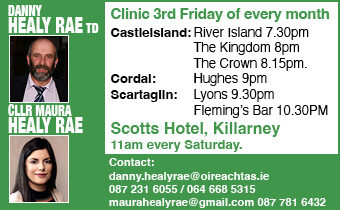
It may pale in significance with what happened elsewhere in the country but the flooding here on January 24th was a real reminder that things can no longer be taken for granted.
Drains, rivers and streams in the area have almost always coped well with whatever the elements threw at them – until now.
Before the big dredging job on the River Maine in the early 1960s, flooding in low-lying areas of the town was a common occurrence.
Since then there have been occasional breaches after or during an exceptional downpour in summer or prolonged rain in wintertime – and they have been very rare.
Friday, January 24th was an exceptional day by any comparison with previous events.
There were streams of water running down roads which had never, in living memory, been seen.

There were, of course, places flooded which had suffered before. Walsh’s Garage in Tullig and its residential neighbours and the residents of Tonbwee on the Scart Road got the real frights on that day as the banker in the River Maine began to subside only as the water lapped, literally inches from entering homes there; Walsh’s Garage suffered a recurrence of a depth of close to a foot of water last seen there in 2008.
The causes are still being debated; the consequences are beyond doubt and the cures are being explored.
I got a call last week from Cllr. John Joe Culloty and he told me he had been asked to examine a culvert which takes the flow from the stream which flooded the Tullig area on that day.
The open stream crosses the Brosna Road beside the Glebe Lodge Residential House and flows down through the field at the back of the houses in Tullig. At the back of Walsh’s Garage it flows into the culvert and across under the garage yard and under the Cordal Road and back to the rising, River Maine. This would be certain to halt any debris in a flood and create a dam there – the consequences of which there is ample evidence.

“I was asked by the residents of Tullig to investigate the culvert adjacent to Walsh’s Garage, as this culvert was unable to take the volume of water, which flowed into it on 24th January last, causing very serious flooding problems in the area,” said Cllr. Culloty.
“When flood waters receded, I walked into the culvert at the rear of Walsh’s Garage, and noticed that this culvert has an opening of 18.6 sq. ft or 1.73 square metres. I proceeded walking along the culvert until I arrived at the point where the council pipe met with the culvert,” said Cllr. Culloty.
The opening of this pipe has an area of 9.2 sq. ft. or .85 sq. mtrs. This pipe continues under the road, where it joins up with a pipe fitted by a resident, which is slightly bigger than the council pipe. As the council pipe is only half the size of the culvert, it is causing a bottle neck effect, which causes flooding at this point,” Cllr. Culloty observed.
At Monday’s Kerry County Council meeting, Cllr. Culloty asked: “’That this council call on the Office of Public Works to provide emergency funding under the Minor Works Non Coastal Scheme, to remove the concrete pipes which go under the public road at Tullig, Castleisland and replace them with culverts which match the existing culvert, thus eliminate the flooding at Tullig, and on the Brosna Road.”
Cllr. Culloty also had a petition from the residents of the area who wish to see this essential work undertaken.
While Cllr. Bobby O’Connell and Cllr. Danny Healy-Rae are in agreement that the river at Ballinahown needs urgent attention and silt removal at danger points; Cllr. John Joe Culloty – while acting on local knowledge – has thrown another valid diagnosis on the table.
However, the question remains: Who in the name of God signed off on the joining under the Cordal Road at Tullig ?
There were songs made about less. – John Reidy, The Maine Valley Post




















































